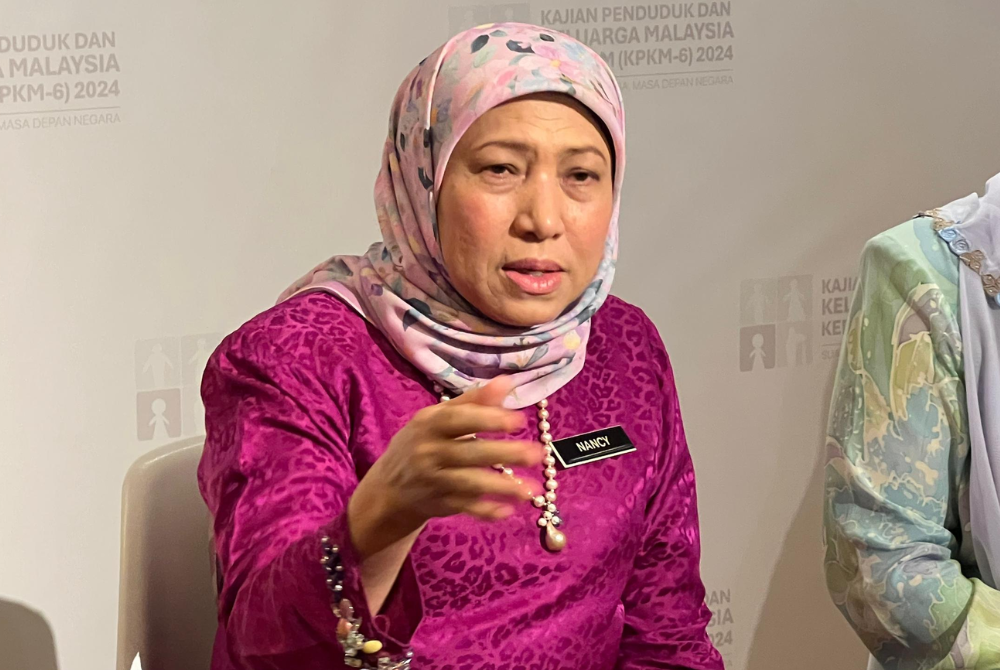Malaysia to experience population shrinkage for the first time in 2072 - Nancy
"Despite the annual increase in population, the annual population growth rate is expected to decline, reaching as low as 0.7 per cent by 2050."

SHAH ALAM - For the first time in history, Malaysia is projected to face a population shrinkage in 2072, reveals Women, Family, and Community Development (KPWKM) Minister Datuk Seri Nancy Shukri.
Based on the 2020 Malaysian Population and Housing Census, Nancy said the country recorded a population of 32.4 million, up from 27.5 million in 2010.
"Despite the annual increase in population, the annual population growth rate is expected to decline, reaching as low as 0.7 per cent by 2050," she said.
Nancy said this trend was significantly influenced by the decrease in the Total Fertility Rate (TFR) among women of reproductive age.
The TFR refers to the average number of children a woman would have if she lived through her reproductive years, typically between the ages of 15 and 49.
According to the 2023 Vital Statistics Report by the Statistics Department (DOSM), the TFR in Malaysia has dropped sharply from 2.1 children in 2010 to 1.6 children in 2022.
This decline places Malaysia's TFR below the level of 2.1 children.
Speaking more on this, Nancy highlighted several factors contributing to this decline in TFR, including economic conditions and lifestyle choices that affect decisions on marriage age, number of children, and fertility issues.
She also emphasised the need for a comprehensive or ‘whole of nation’ approach to address this declining trend.
"A lower TFR accelerates population aging, with 15 per cent of Malaysia’s population expected to be aged 60 and above by 2030.
"If this trend continues, Malaysia will experience population shrinkage for the first time in 2072.
"Malaysia's population is projected to keep increasing until it reaches a peak of 46.09 million in 2071. However, it will start to decline to 46.08 million in 2072 and continue decreasing to 44.58 million by 2100," she said.
Nancy also said that the demographic shift would increase pressure on the current and future workforce.
"This trend will increase pressure on our current and future workforce and talent supply.
"Our workforce is projected to decrease from 65.5 per cent in 2020 to 63.5 per cent in 2030 and continue declining by 2050 and we already have an issue with women labour participation, which is currently only at 56 per cent," she added.
To address these issues, Nancy said the Women, Family, and Community Development Ministry has implemented various initiatives through its agencies, including fertility and subfertility services since 1979, men’s wellness clinics, financial incentives such as tax exemptions for fertility treatments and subsidies for daycare fees.
However, Nancy said these initiatives were insufficient picking the Malaysian Family Well-being Index (IKK) study by the National Population and Family Development Board (LPPKN) revealed a decline in the ‘work-life balance’ indicator in 2022 compared to 2019.
Additionally, the Fifth Malaysian Population and Family Survey (KPKM-5) found that over one-third (34.2 per cent) of working women require childcare centres at their workplace, followed by facilities for taking leave to care for sick children (17.8 per cent) and flexible working hours (13.7 per cent).
Among women who left the workforce, a third (32.4 per cent) cited childcare issues as the main reason.
Therefore, Nancy highlighted the necessity of improving work-life balance and flexible working hours, stressing the economic benefits of women's labor participation.
"In urban areas, households with both spouses working earned 61 per cent more than those with only one working spouse, and in rural areas, this difference was nearly 74 per cent.
"We need more work-life balance and flexible hours. And why do we need women to work? Because households where both women and men worked had significantly more income. These are the data we live with and we must act on it," she said.
The government seeks cooperation from all sectors to address population development issues, ensuring the country's and its people's well-being in the future.











